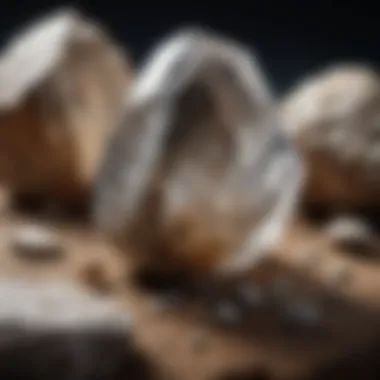Crystal Identification Guide: Discover and Classify Crystals


Intro
The world of crystals is vast and intricate. For collectors, whether beginners or seasoned experts, understanding how to identify these beautiful formations is key. Crystals are not simply decorations; they can reveal information about geological processes, environmental conditions, and even historical contexts. This guide serves as a foundational resource for those looking to delve into the complex process of crystal identification. Through careful examination of physical attributes and a grasp of scientific classification, you will cultivate skills that elevate your collecting experience.
Furthermore, by enhancing your observational techniques, you will gain confidence in recognizing and categorizing the crystals you encounter. This guide emphasizes not just the aesthetic qualities of crystals but also the scientific principles that underpin their formation. Therefore, it is imperative to approach crystal identification with both a critical eye and an open mind.
Featured Collectible of the Month
Overview
This month, the focus is on Amethyst, a captivating violet variety of quartz. Amethyst is appreciated not only for its beauty but also for its potential metaphysical properties. Often found in geodes, this crystal can display an array of purple shades, ranging from pale lavender to deep, rich purple. Its formation process involves the cooling of lava and the subsequent mineral crystallization within rock cavities.
Historical Significance
Historically, Amethyst has held considerable significance. In ancient times, it was associated with protection and clarity. Greeks believed it could ward off intoxication, with the name itself derived from the Greek word amethystos, which translates to "not intoxicated." Moreover, in the Middle Ages, it was worn by bishops, symbolizing piety and humility. Today, it remains a sought-after stone among collectors and enthusiasts alike, representing both a connection to history and natural beauty.
Identification Techniques
Visual Characteristics
When identifying crystals, several visual traits are critical. Look for clarity, color, form, and luster. Amethyst, for instance, showcases a distinctive purple hue, with variations often providing clues about purity and crystalline structure.
- Clarity: Observe how transparent or translucent the stone is.
- Color: Note any color zoning or banding that may exist.
- Form: Recognize the natural crystal shape, which can be prisms, clusters, or geodes.
- Luster: Assess whether the surface reflects light in a glassy, resinous, or dull manner.
Resources for Identification
Utilizing the right resources can enhance your crystal identification journey. There are various comprehensive books, online databases, and websites that provide detailed information on crystals.
- Wikipedia: A valuable starting point for general information about crystals.
- Britannica: Offers well-researched articles on specific mineral types.
- Reddit: Communities focused on mineralogy can provide personal insights and experiences.
- Facebook: Groups dedicated to rock and fossil collecting can serve as a platform for sharing information and advice.
"Identifying crystals is both an art and a science, requiring a combination of observational skills and knowledge."
In summary, understanding crystals involves appreciating their physical traits, historical context, and employing various resources for accurate identification. As you learn more about stones like Amethyst, you will develop a deeper connection to your collection and an appreciation for the natural world.
Prologue to Crystal Identification
Crystal identification is a critical skill for those engaged in mineral collecting, geology, and even in practical applications such as jewelry making. Knowing how to correctly identify crystals not only provides insight into their properties but also enhances appreciation for their beauty and uniqueness. Understanding the intricacies of each crystal type allows enthusiasts to make informed decisions when collecting and categorizing specimens.
Importance of Crystal Identification
Identifying crystals is essential for various reasons. Firstly, it aids in understanding the geological processes that result in the formation of different minerals. Each crystal reflects its environmental conditions and chemical composition. Knowing this helps in contextualizing where these crystals may be found in nature.
Moreover, proper identification can prevent costly mistakes when purchasing crystals or minerals. For collectors, distinguishing between high-quality specimens and imitations can often be the difference between a valuable investment and mere decorative pieces. Additionally, many crystals have metaphysical attributes assigned to them, which relies heavily on accurate identification.
Summarily, crystal identification enhances the collector's experience, enabling greater interaction with the natural world.
Goals of This Guide
This guide aims to demystify the process of crystal identification, making it accessible to both beginners and advanced collectors. The primary goals include:
- Providing Comprehensive Knowledge: Each section is designed to delve into crucial aspects of crystal properties, classification, and techniques, ensuring readers have a well-rounded understanding.
- Promoting Observational Skills: Emphasis is placed on developing careful observation techniques, which are key to effective identification.
- Encouraging Practical Application: Readers will find actionable advice on how to use their newfound knowledge in real-world contexts, whether that’s in fieldwork or during a buying decision at a mineral show.
By guiding the reader through essential topics, this guide seeks to build confidence in their ability to identify and appreciate various crystals.
Basic Properties of Crystals
Understanding the basic properties of crystals is essential for crystal identification and appreciation. These properties serve as distinctive features that help enthusiasts distinguish one crystal from another. Knowledge about physical characteristics and chemical composition not only enhances the collector's experience but also informs practical identification techniques. A solid grasp of these elements enables both novice and advanced collectors to recognize crystals and understand their origins, uses, and significance in geology and various applications.
Physical Characteristics
Color
Color is a primary physical characteristic that often draws initial attention. Each crystal type displays a specific range of colors due to variations in their chemical composition and the presence of trace elements. For instance, the color of Amethyst ranges from light lavender to deep purple, while Citrine presents a spectrum of yellow hues. The key character of color is its ability to provide immediate visual cues for identification. However, while visually appealing, relying solely on color can be misleading. Some crystals may change colors based on lighting or impurities within.
Unique features of color include its spectrum. The brightness or dullness can influence not just aesthetic value, but also market desirability. Some enthusiasts might prefer brightly colored specimens, while others may value rare colors that are less seen in nature. However, caution is warranted as many crystals might have similar colors, thus necessitating further investigation beyond just the visual aspect.
Transparency
Transparency describes how light passes through a crystal. It can be classified as opaque, transparent, or translucent. For example, Clear Quartz is transparent, allowing light to pass effortlessly, while Pyrite is generally opaque. This characteristic is essential for both aesthetic evaluation and practical identification. Transparency can indicate purity; highly transparent crystals are often regarded as more valuable.


A unique feature of transparency is its influence on light play within a crystal. Crystals that refract light exceptionally well can appear more striking. However, not all transparent crystals are created equal. Variations in clarity can also impact value and identification, as some might showcase inclusions or internal fractures that affect overall appearance.
Luster
Luster refers to the quality of light reflection from a crystal's surface. Common types of luster include vitreous (glassy), metallic, and dull. For example, Calcite exhibits a vitreous luster, giving it a bright appearance, while Galena shows a metallic luster, making it shine significantly. Luster serves as a critical feature in identifying and categorizing crystals, providing insights into their surface conditions and chemical compositions.
The unique feature of luster lies in its variety, which can convey valuable information about a crystal's origin and processing. While a shiny luster may make a crystal more visually appealing, some collectors might appreciate those with a dull or earthy luster for their natural, unrefined quality. Yet, luster can sometimes be misleading, as weathered specimens may lose their original sheen, requiring further tests for accurate identification.
Chemical Composition
Mineral Groups
The mineral groups are classifications based on similar chemical structures and compositions among crystals. Understanding these groups allows one to navigate the vast world of crystals more effectively. Silicates, for instance, constitute the most abundant group of minerals found in the Earth’s crust, including Quartz and Feldspar. Recognizing the significance of mineral groups simplifies the identification process by categorizing crystals based on fundamental properties.
A notable characteristic of mineral groups is their utility in identifying crystals systematically. Many resources and guides categorize minerals in this way, making it easier for collectors to approach identification. However, relying on mineral groups does require a certain level of familiarity with the myriad of classifications, which might overwhelm beginners in the field.
Common Elements
Common elements in crystals often dictate their properties, appearance, and classification. Elements such as silicon, oxygen, and aluminum frequently appear in many crystals, affecting their chemical and physical attributes. Knowledge of common elements can assist in identifying and placing crystals into their respective groups, thus enhancing accuracy in classification.
The importance of recognizing these common elements lies in their implications for identification and potential applications. Understanding elemental composition can lead to deeper insights into the uses of certain crystals in industry, technology, or spiritual practices. However, the predominance of specific elements in multiple crystals may also lead to confusion, thus necessitating a nuanced understanding of how these elements influence each crystal's overall characteristics.
Classification of Crystals
The classification of crystals is fundamental to the study of mineralogy. It allows enthusiasts and experts alike to understand the vast diversity within the mineral kingdom. By categorizing crystals into distinct types, identification and analysis become more organized and systematic. This guide highlights various aspects of crystal classification, emphasizing crystallographic systems and mineral groups. Understanding these classifications can enhance one's ability to identify and appreciate crystals accurately.
Crystallographic Systems
Isometric
The isometric system is one of the most straightforward crystal systems. It features equal lengths and angles, creating a symmetrical appearance. This system includes well-known minerals such as cubic pyrite and halite. Its key characteristic of uniformity makes it a popular choice for collectors. Isometric crystals are easy to differentiate due to their geometric shape and often reflect light in a striking manner. However, some may find the limited variety within this system a disadvantage when compared to others.
Tetragonal
In contrast, the tetragonal system provides more variation in dimensions. Tetragonal crystals have one axis longer or shorter than the others, resulting in a rectangular base. Minas Gerais quartz often exemplifies this system. The unique feature of the tetragonal class is the presence of elongated shapes, which can be attractive to collectors. However, this aspect might complicate identification for novices, as distinguishing it from related systems can be challenging.
Hexagonal
The hexagonal system stands out due to its six-sided symmetry. Crystals in this system include familiar examples like quartz and beryl. The key characteristic here is the ability to form complex structures, leading to fascinating mineral formations. Hexagonal crystals typically exhibit distinct crystal facets, enhancing their visual appeal. The potential complexity in this system presents both an advantage for collectors seeking unique specimens and a challenge for those less experienced.
Identification by Mineral Groups
Silicates
Silicates represent the largest group of minerals on earth. These compounds are formed with silicon and oxygen, often combined with metals. Common silicates include quartz and mica. Their key characteristic lies in their tetrahedral structure, making them versatile in nature. For this article, their prominence and diverse appearances make silicates a focal point of identification. One disadvantage is the vast number of variations, which can complicate specific identification without thorough study.
Carbonates
Carbonate minerals are significant for their role in geology and the environment. Composed primarily of carbonate ions, minerals like calcite share both beauty and utility. Their unique feature is effervescence when exposed to acid, a distinct identifying trait. For users interested in practical applications, carbonates are beneficial as they are abundant and found in various locations. However, their resemblance to some other mineral groups can create confusion without careful observation.
Oxides
Oxides are essential for understanding mineral composition. These minerals consist of oxygen combined with metals, such as magnetite and hematite. Their key characteristic is the strong bonding, which often results in higher hardness compared to some other groups. This property is beneficial for collectors seeking durable specimens. The downside is that less familiar collectors may find difficulty distinguishing between different oxides due to their often-similar appearances.
This classification not only aids in identification but also enriches our understanding of mineral formation and their properties.
Understanding these classifications allows for a more informed approach to crystal identification, contributing significantly to both scientific study and personal enjoyment in the world of minerals.
Key Identification Techniques
Identifying crystals accurately relies heavily on effective techniques. Various methods exist, and each contributes uniquely to the understanding and categorization of crystals. Techniques range from simple visual inspection to more sophisticated tools. This section focuses on two main elements: observation techniques and the tools that aid in these identification processes. By mastering these methods, enthusiasts can improve their skills and confidence in identifying crystals.
Observation Techniques
Visual Inspection
Visual inspection is a fundamental aspect of identifying crystals. This method involves closely examining physical traits such as color, shape, and surface texture. Being able to discern these characteristics is essential since they can provide insights into the crystal type. The key characteristic of visual inspection is its immediate accessibility; anyone can do it without requiring specialized tools. This ease of use makes it a beneficial choice for both novices and seasoned collectors alike.
The unique feature of this technique lies in its emphasis on the eyes’ ability to capture subtle details. However, one should acknowledge that visual inspection has its limitations. Conditions like ambient lighting or dirt on the surface can skew observations. Therefore, it is crucial to complement visual skills with other techniques to confirm identifications.
Touch and Feel


Touch and feel techniques expand the understanding of crystal properties further. This method includes assessing the texture, weight, and overall feel of the crystal sample. The tactile characteristic of touch and feel is important. It adds another layer of information regarding the mineral’s density and surface qualities.
This technique is particularly beneficial in distinguishing between crystals that may visually appear similar. The unique feature of using tactile senses is its direct engagement with the material, which can lead to a more personal connection to the specimen. However, it is essential to note that this approach may not always yield distinct differences. Some crystals may feel similar, requiring additional methods for proper identification.
Tools for Identification
Hand Lens
A hand lens is a crucial tool for crystal identification. It magnifies details that are not visible to the naked eye, allowing for a closer examination of crystal structure and any distinguishing features. The key characteristic of a hand lens is its portability and ease of use. It is a popular choice among enthusiasts because it enables quick and effective assessments in the field.
The unique feature of a hand lens is its capacity to reveal intricate patterns and inclusions within crystals. However, while it enhances observation, it can also lead to misidentifications if users become overly reliant on it without correlating other methods. Using a hand lens wisely means combining it with visual and tactile assessments.
Field Guidebooks
Field guidebooks serve as invaluable resources for crystal identification. These books provide descriptive details about various crystal types, helping collectors make informed judgments on their specimens. The key characteristic of field guidebooks is their comprehensive compilation of information, which includes illustrations and usage tips.
Guidebooks hold a unique advantage: they can be readily consulted in the field, offering immediate reference. However, not all guidebooks are of equal quality. Some may lack recent research or inclusivity of various regions, limiting their effectiveness as a reliable resource. Choosing an updated and thorough guidebook is crucial for serious collectors.
Testing Kits
Testing kits offer a more scientific approach to crystal identification. These kits typically include tools for assessing hardness, streak, and other mineral properties. The key characteristic of testing kits lies in their systematic methodology, providing more definitive results than visual or tactile methods alone.
What makes testing kits unique is their ability to quantify properties that determine mineral classification. However, the use of such kits demands a certain level of knowledge and experience. New collectors might find the process daunting and may need guidance to interpret results correctly. Investing time in understanding the kits ensures they are used effectively.
In summary, mastering these identification techniques and tools is key to becoming proficient in recognizing and categorizing crystals. Each method has its strengths and weaknesses, and effective identification often requires combining several approaches.
Common Crystals and Their Identification
Understanding common crystals is essential for those interested in mineralogy or even casual collectors. Identification plays a crucial role because many crystals share similar physical characteristics but differ chemically and structurally. By recognizing these differences, collectors can make informed decisions regarding purchase, authenticity, or usage. The ability to identify crystals accurately not only enhances your collection but also increases appreciation for their unique properties.
Quartz Varieties
Clear Quartz
Clear quartz is perhaps one of the most recognizable crystals. Its transparency and ability to refract light make it a favorite among collectors. The key characteristic of clear quartz lies in its physical purity. It is often used in various applications, from jewelry to electronics. Its common availability and low cost are significant advantages. However, the clarity also may attract similarity with other types of quartz. Therefore, attention to specific characteristics is important when authenticating this crystal.
Amethyst
Amethyst is a popular variety of quartz, distinguished by its rich purple color. This crystal holds a special place in the hearts of collectors and jewelers alike. The key characteristic of amethyst is its striking hue, which comes from trace amounts of iron and other elements in its structure. Amethyst is commonly used in jewelry due to its aesthetic appeal and is considered beneficial in various healing traditions. Its value can fluctuate, so collectors should remain vigilant of authenticity and possible treatments.
Citrine
Citrine is another variety of quartz known for its yellow to brownish colors. The characteristic that stands out is its warmth, making it quite appealing in decorative items and jewelry. Citrine is often associated with prosperity and abundance. One unique feature of citrine is that it is often confused with other yellow-colored gemstones like yellow sapphire. This similarity can lead to misidentifications, making knowledge of its physical traits crucial for collectors.
Other Popular Crystals
Fluorite
Fluorite is easily identified by its vibrant colors, which can range from clear to green, purple, or yellow. The significance of fluorite lies in its cubic structure and its versatility in education and industry. Its key characteristic is fluorescence, where the crystal exhibits various colors under UV light. This unique feature makes fluorite a fascinating choice for collectors. However, its softness can be a disadvantage, making it more susceptible to scratches and damage.
Calcite
Calcite is often underestimated due to its abundance, but it has unique identification traits. Commonly found in a variety of colors, it exhibits strong effervescence when exposed to acid, a critical factor in its identification. The importance of calcite is evident in its use for geological studies. The disadvantage of calcite is its variable colors, which can lead to confusion with other minerals. Therefore, a thorough understanding of its properties is beneficial for proper identification.
Pyrite
Often referred to as "fools’ gold," pyrite is notable due to its metallic luster and brassy color. Its contribution to the topic of crystals is significant, especially as a common mineral found in various geological settings. The key characteristic of pyrite is its hardness and shape, often forming cubic crystals. While it attracts collectors, the common misconception about its value is a disadvantage. Recognizing its true identity is crucial to avoid confusion with real gold or other valuable minerals.
In summary, familiarity with common crystals enhances identification skills, which is critical for collectors and enthusiasts alike.
By focusing on these crystals and their unique attributes, individuals can improve their identification skills and deepen their appreciation for the intricacies of crystals.
Environmental and Geological Context
Understanding the environmental and geological context of crystals is essential for accurate identification and appreciation. Crystals form under specific conditions that reflect the geological history of their surroundings. Knowing these conditions helps collectors and enthusiasts recognize that distinct crystals can be indicators of the geological processes at play. This context enables one to predict where certain types of crystals might be found, adding depth to both collecting and studying crystals.
Geological Settings
Mineral Deposits
Mineral deposits are concentrations of minerals that accumulate in specific locations due to geological processes. These deposits can be prolific sources for various crystals. One key characteristic of mineral deposits is their diversity, which includes a range of crystals from common quartz to rarer minerals. This diversity makes them an appealing subject for identification, contributing significantly to the overall understanding of crystal formation and distribution.


One unique feature of mineral deposits is their occurrence in different geological settings, such as igneous, sedimentary, and metamorphic environments. Each of these settings presents distinct advantages and disadvantages in terms of accessibility and rarity of crystals. For instance, while sedimentary deposits may yield more familiar crystals, they can also hide extraordinary finds within layers of rock. Therefore, exploring these deposits enriches the knowledge of not just the crystals, but also their natural history.
Formation Processes
The processes by which crystals form are crucial for identification. Formation processes can generally be classified as crystallization from a melt, evaporation from a solution, or the alteration of existing minerals. Each process affects the resulting crystal’s properties and is a critical element in their identification.
A notable characteristic of formation processes is that they dictate the crystalline structure and chemical composition of the resulting minerals. Identifying these processes is beneficial for understanding not only the crystals themselves but also for correlating them with their geological history.
For example, crystals formed from evaporation of saltwater may differ significantly in their structure and composition from those solidified from molten rock. However, understanding these processes can be complex. In some instances, crystals formed by similar processes might look alike but have distinct chemical properties. Thus, gaining insight into how specific crystals form aids in identifying them accurately.
Local vs. Global Occurrence
Geological settings influence the distribution of crystals, leading to the phenomenon of local versus global occurrence. Certain crystals are endemic to specific regions, while others can be found in numerous places worldwide. Knowing this can greatly aid collectors in their search and enhance their understanding of the diversity present in mineralogy.
Regional Varieties
Regional varieties of crystals often reveal the unique geochemical environments from which they originate. Each area may boast its specific inclusions, colors, and forms. This uniqueness adds significant value, both monetarily and scientifically, as distinct varieties can often reflect varied conditions of formation.
Collectors benefit from understanding these regional nuances as they can provide insights into geological conditions that shaped the crystals. One disadvantage, though, is that regional varieties can sometimes be difficult to identify without clear reference points. Often, photographs and samples are necessary for accurate classification.
Commercial Sources
Commercial sources for crystals often include various mining operations and geological suppliers. These sources make it accessible for collectors to acquire crystals without needing to physically search geological sites. A primary advantage is the convenience, enabling collectors to broaden their collections rapidly without having extensive geological knowledge.
However, one disadvantage can be the over-commercialization of some crystals, sometimes resulting in unethical mining practices or environmental degradation. It's vital for collectors to seek crystals from reputable sources that adhere to ethical standards. This not only ensures the integrity of their collection but also promotes responsible practices in the crystal industry.
"The understanding of environmental and geological context in crystal identification enhances the ability to connect with the natural world and appreciate the intricate processes behind crystal formation."
Record Keeping and Documentation
Record keeping and documentation are essential aspects of crystal identification. They serve multiple functions that can enhance both personal collections and scientific understanding. A systematic approach to documentation provides clarity, organization, and a sense of permanence to the features you observe in various crystals. This is particularly useful for tracking your progress as a collector or researcher, documenting each find with care and precision.
Importance of Documentation
The importance of documentation cannot be overstated in the field of crystal identification. It acts as a structured method to record not just the physical attributes of crystals, but also their geographical origins, associated minerals, and even anecdotes surrounding their discovery. Good documentation practices facilitate easy retrieval of information.
Moreover, they provide a reference point for future comparisons or studies. For seasoned collectors and enthusiasts alike, the ability to reference past identifications aids in honing observational skills. This leads to a deeper understanding of the diversity and nuances inherent in mineralogy. Thus, proper documentation is an investment in knowledge that pays dividends over time.
Methods of Packaging Information
Journals
Journals are a popular method for packaging information regarding crystal finds. They allow for free-form notes and sketches, which can capture unique details that photographs may not convey. The key characteristic of journals is their tactile aspect; the act of writing down information can foster a more profound connection to each specimen.
Additionally, journals allow for a chronological narrative of your collecting journey, making it easy to trace back through your entries. A significant benefit is that there are no technical barriers as with digital tools; anyone can start recording information immediately with minimal setup. However, a downside is that journals can be physically misplaced or damaged more easily than digital files.
Digital Records
Digital records offer a modern approach to documentation, making them increasingly popular among collectors. The key feature of digital records is their accessibility and ease of sharing. With digital platforms, one can easily categorize and tag entries, making it simple to retrieve specific information quickly.
Another advantage is the ability to back up data, reducing the risk of loss from accidental damage. However, digital methods may introduce a level of complexity not present in analog systems. Not everyone is comfortable with technology, leading to potential barriers in adoption. Nevertheless, digital records, when utilized effectively, can greatly enhance the efficiency of tracking and managing a crystal collection.
"Effective documentation not only preserves knowledge but enriches the collector's journey."
In summary, both journals and digital records provide effective means for tracking crystal collections and experiences. The choice between them may depend on individual preference, but both options greatly contribute to the overarching goals of crystal identification.
Finale and Further Resources
Understanding crystal identification is an essential skill for anyone involved in collecting minerals, whether they are beginners or seasoned experts. This section highlights the significance of mastering the identification process and offers access to valuable resources that can enhance one’s knowledge.
Identifying crystals accurately provides insight into their properties and origins. It no only enriches your collection but also deepens your appreciation for the beauty and complexity of natural minerals. Clear documentation of your findings can also facilitate future studies and sharing knowledge with fellow enthusiasts. With strong observational skills, you can enjoy your collection much more and also extend your expertise into educational aspects.
Summary of Key Points
- Crystal identification involves understanding physical characteristics and chemical compositions.
- Fundamental techniques include visual inspection and utilization of tools such as hand lenses.
- Contextual understanding improves identification as different geological environments yield specific mineral types.
- Accurate record-keeping is crucial for documentation and analysis of your crystal finds.
Recommended Literature and Websites
To further enhance your expertise in crystal identification, consider exploring these resources:
- Books:
- Websites:
- "Minerals of the World" offers extensive descriptions of different minerals.
- "Gemstones of the World" provides insights into the identification and properties of various gemstone types.
- Wikipedia
- Britannica
- Reddit has active communities discussing identification techniques and mineral properties.
Utilizing these materials will deepen your understanding and proficiency in identifying a variety of crystals. Make the effort to connect with fellow collectors in forums and communities for continuing education and assistance.



